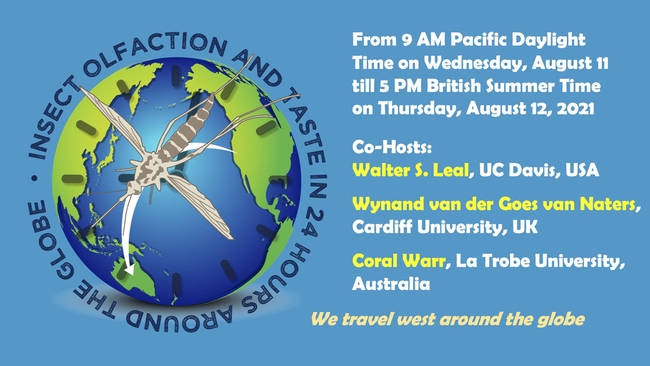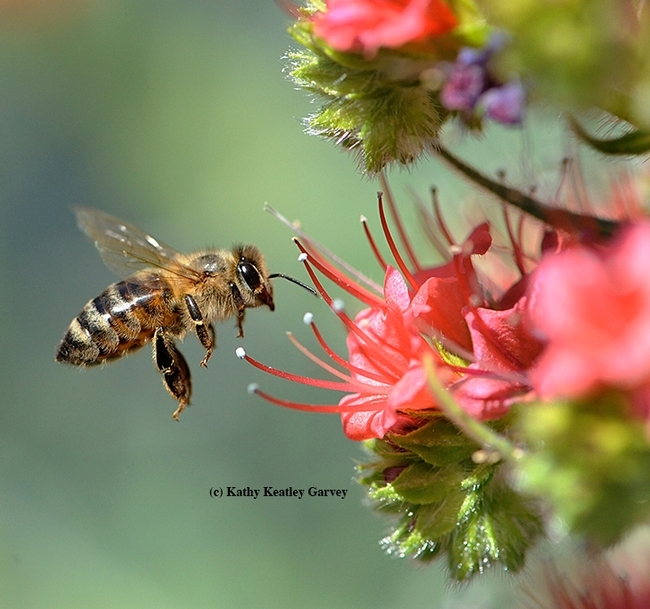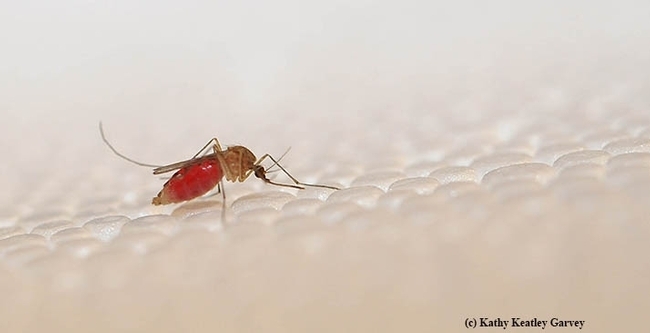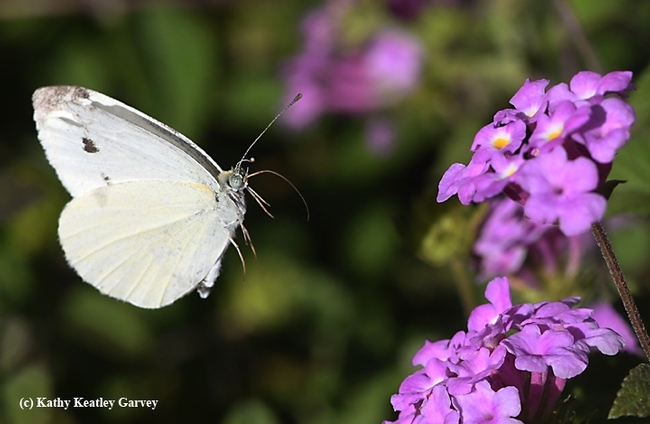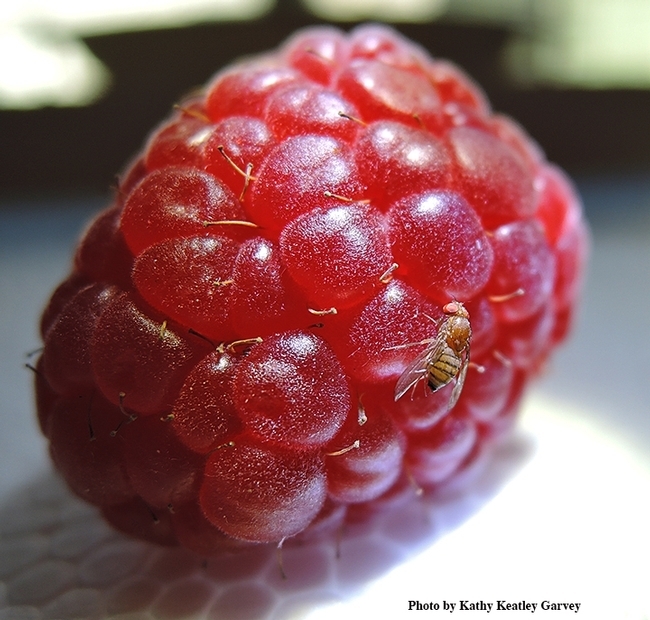- Author: Kathy Keatley Garvey
Hey, wait, take me with you!
No, leave me alone! Let me go!
Have you ever seen insects struggling to free themselves from the reproductive chamber of a milkweed blossom?
Instead of producing loose pollen grains, milkweeds produce pollinia, a waxy, sticky packet of golden pollen grains originating from a single anther. When bees and other insects forage for nectar in the "nectar troughs," where the pollinia are, they emerge with wishbone-shaped pollinia on their feet or other body parts. That is, if they emerge at all. Sometimes they die there; the reproductive chamber becomes a floral death trap.
What may seem like nature's appalling act of cruelty is actually a unique case of floral pollination, the transfer of pollina from one blossom to another.
"Milkweed flowers bloom in umbels which are clusters of individual flowers on stems that emerge from a common point," explains Eric Eldredge in an article published by the U.S. Department of Agriculture's Natural Resources Conservation Service. "Flowers of different species of milkweed differ in size, color, and fragrance, but all produce their pollen in waxy sacs called pollinia. The pollinia are located in two anther pouches adjacent to vertical stigmatic slits of the flowers. Pairs of adjacent pollinia are connected to each other by translator arms from a clamp located in the middle, called the corpusculum (Bookman, 1981). The complete structure is called a pollinarium."
"Insects that visit a flower to drink nectar struggle to grasp the slippery surfaces and may accidentally slip their leg, tarsus, mouthpart, or other appendage into the opening at the bottom of the stigmatic slit. This slit is formed by guide rails, which are lined with bristles that prevent the insect moving its appendage any direction but up. The top of the slit leads into the opening of the corpusculum, which has hard, sharp inside edges that taper together at the top. The corpusculum clamps firmly to the insect by pinching onto the insect's appendage. In its struggles to escape, if the insect is large enough, it can withdraw the paired pollinia from the anther pouches and fly away."
We've seen dead honey bees trapped in the milkweed blossoms while other bees forage around their carcasses. And then we've seen the frantic struggles (below). Fortunately this bee in the first three photos escaped. Another bee did not.
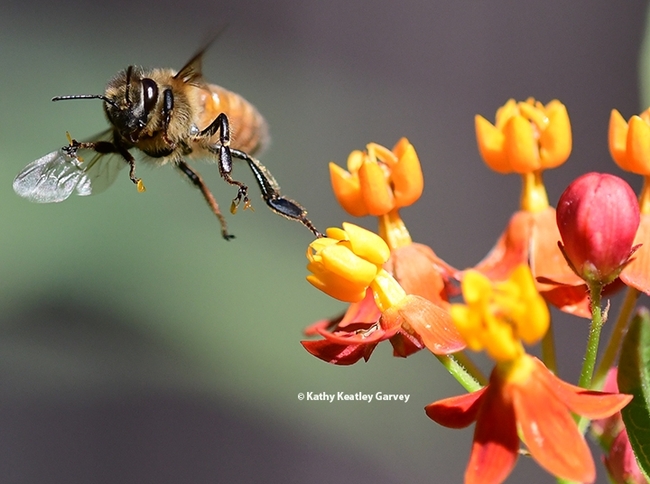
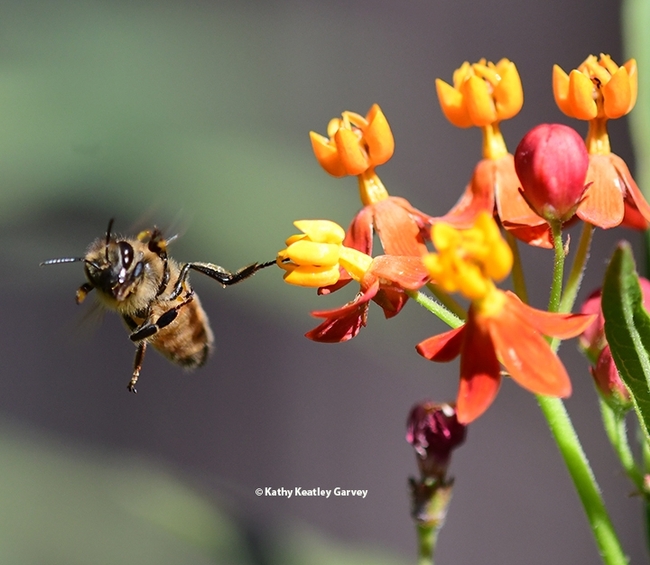
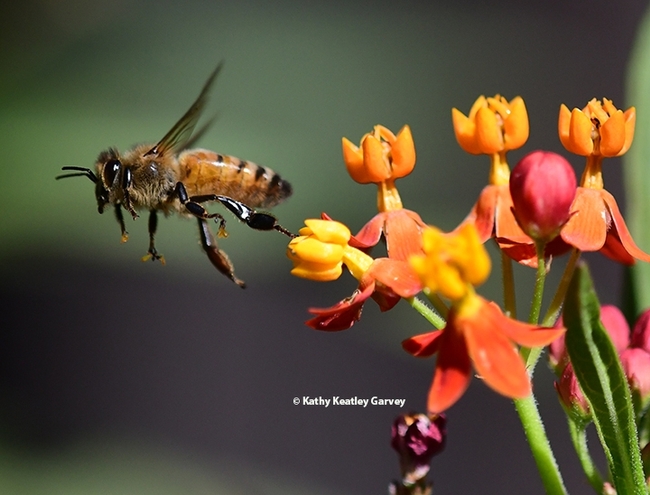
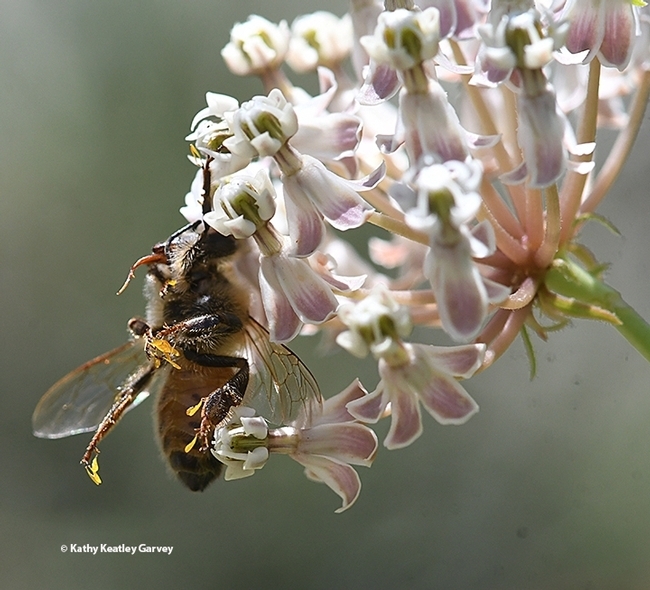
- Author: Kathy Keatley Garvey
So, here you are, a honey bee nectaring on a Mexican sunflower, Tithonia rotundifola.
All's right with the world, at least in your world. You're sipping nectar to take home to your colony and suddenly...a buzz.
A male long-horned bee, probably Melissodes agilis, is trying to dislodge you from your flower.
You hold your ground (your flower) but you let him know that his presence is unwanted. You lift a foreleg in your defense to block him.
The long-horned bee flies off, and you continue to nectar. All's right with the world. (Until your next encounter with a fast-moving, highly territorial male long-horned bee bent on dislodging you from your flower.)
The late Robbin Thorp (1933-2019), distinguished emeritus professor of entomology at UC Davis, used to say that these male long-horned bees target any critter residing on "their" flowers. It could be a honey bee, a bumble bee, a carpenter bee, a syrphid fly, a butterfly or a beetle. Or something else. They want to save the flowers for their own species and then mate with them, he said.
Just a day in the life of a non-native honey bee, Apis mellifera, and a native long-horned bee, Melissodes agilis.

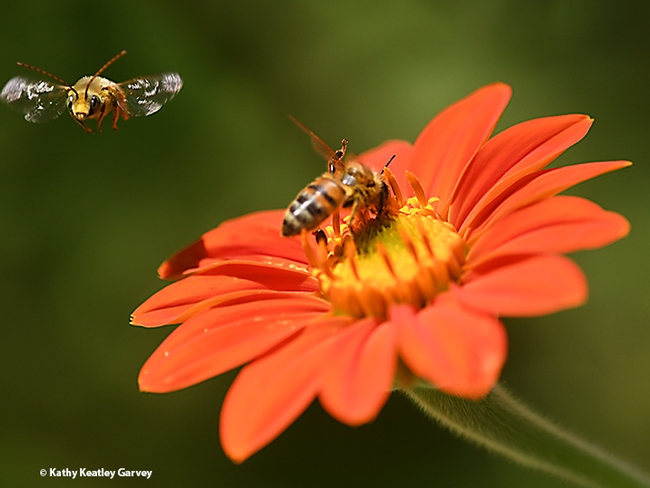
- Author: Kathy Keatley Garvey
The spider failed to snag a butterfly, so it went for Plan Bee.
That would be the honey bee, Apis mellifera.
The bee is usually foraging for nectar and pollen and not that aware of her surroundings, especially a cunning and very hungry spider.
So this orbweaver lies in wait for prey to appear on its "dinner plate." A venomous bite and the bee is paralyzed. And dinner is served à la carte.
It's not what Ernest Hemingway would call a pretty sight. But then again, everything eats in the garden.
Repeat: Everything eats in the garden whether we want it to or not.
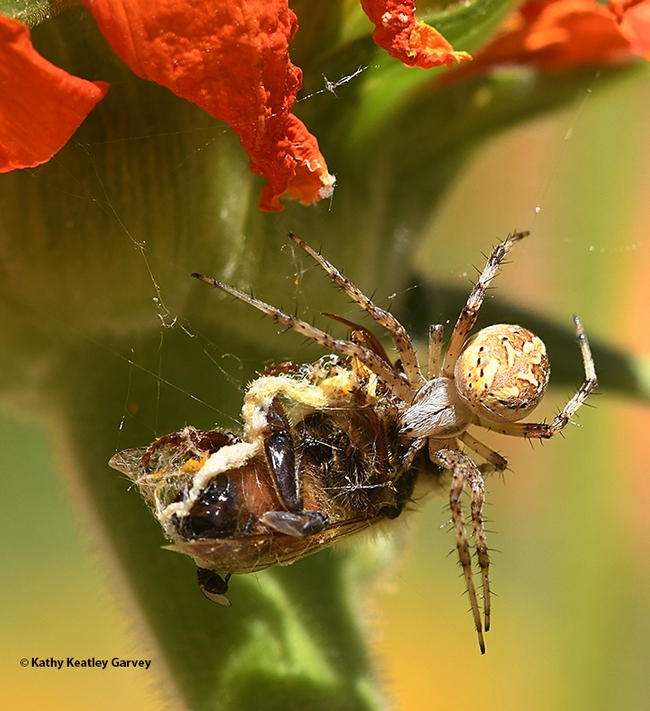
- Author: Kathy Keatley Garvey
Oh, to be a praying mantis, and hide among the flowers waiting for prey.
On a warm sunny morning in Vacaville, Calif., this female Stagmomantis limbata positioned herself in a patch of Mexican sunflowers, Tithonia rotundifola.
She lurked beneath a blossom, camouflaged with the green leaves and stems. She groomed herself. It's important to wash up before breakfast and be presentable at the breakfast table and say your prayers.
Then she spotted a honey bee.
Ms. Mantis climbed the stem and peered over the orange petals.
What happened next? Spoiler alert, no breakfast for Ms. Mantis.
Later, though, another mantis hanging out in a nearby rosebush snagged and ate a small fly and a slow milkweed bug. Satiated, she crawled beneath a leaf, perhaps to digest her breakfast and sleep. You could say she "rose" to the occasion, or you could just say she was hungry.
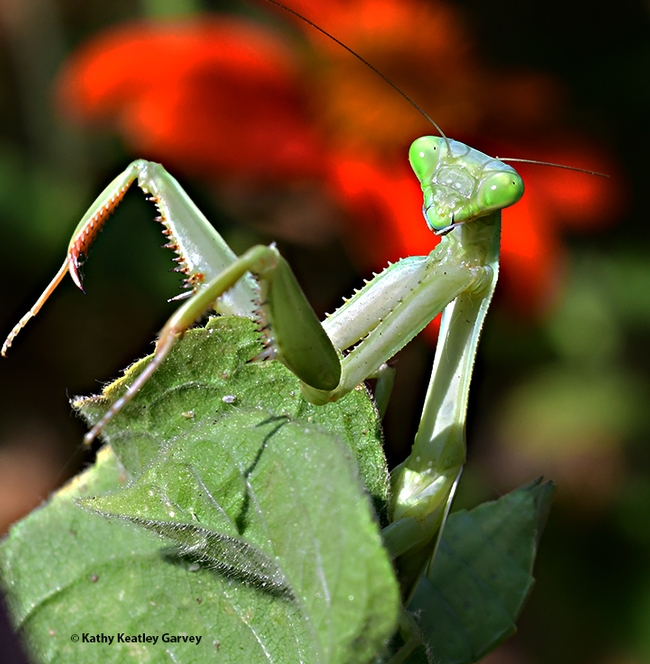
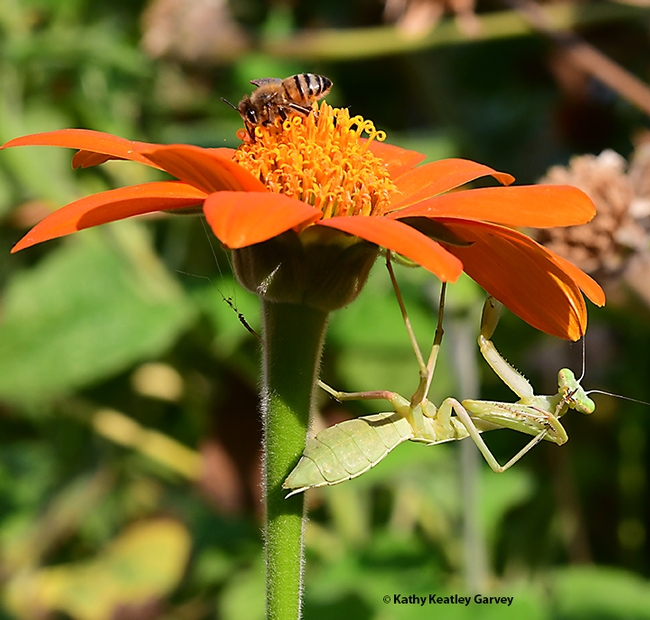
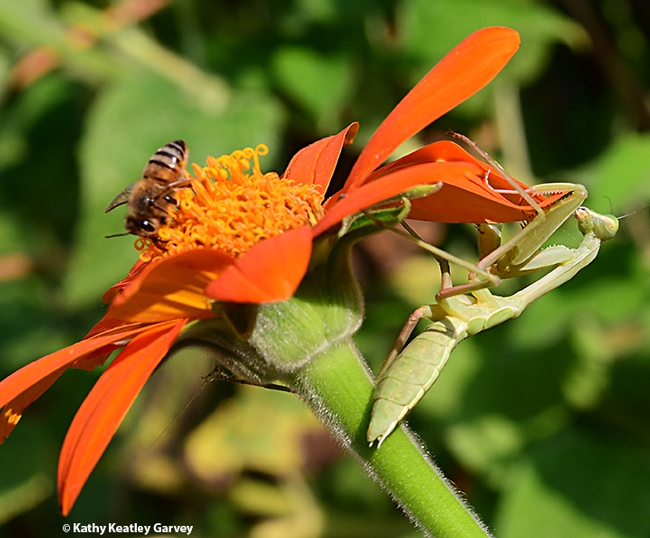
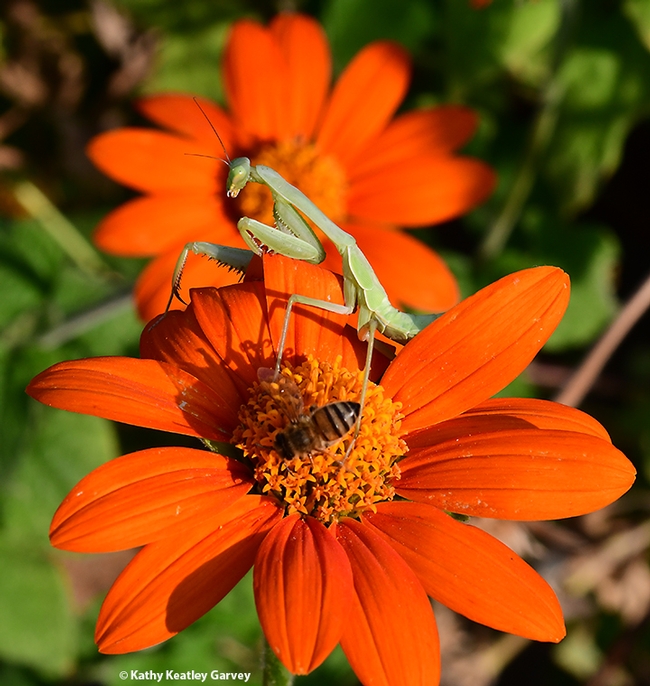
- Author: Kathy Keatley Garvey
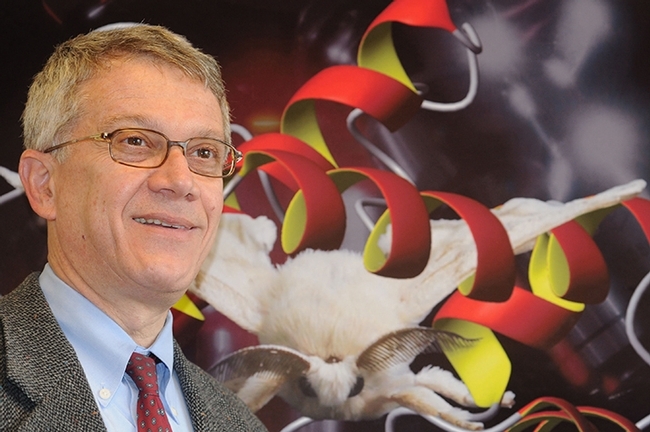
You'll hear about a variety of insects when the international symposium, “Insect Olfaction and Taste in 24 Hours Around the Globe,” takes place beginning at 9 a.m., Pacific Daylight Time (PDT), Wednesday, Aug. 11.
The 24-hour Zoom symposium has already drawn more than 1100 registrants from 66 countries, according to UC Davis distinguished professor Walter Leal, one of the three co-hosts. It's free and open to all interested persons. You can register at https://bit.ly/3k68c2m.
The speakers will focus on a wide variety of insects, including three species of mosquitoes (Culex, Aedes and Anopheles); honey bee (Apis mellifera); fruit flies (Drosophila melanogaster, Drosophila sechellia, and Drosophila suzukii); sand flies (the blood-sucking dipteran flies); cotton bollworm (Helicoverpa armigera); housefly (Musca domestica); cabbage butterfly (Pieris rapae); and the American cockroach (Periplaneta americana).

“We will have 15 invited (keynote) and 36 contribution presentations,” said Leal, who will host the PDT segment. One of the interviews will feature olfaction research pioneer Karl-Ernst Kaissling of Germany.
Co-hosts with Leal are Wynand van der Goes van Naters of Cardiff University, UK, who will host the British Summer Time (BST) segment; and Coral Warr of La Trobe University, Australia (formerly of the University of Tasmania), host of the Australia Eastern Standard Time (AEST) segment. The trio, along with Karen Menuz (PDT), Wei Xu (AEST), and Emmanuelle Jacquin-Joly (BST), will moderate the symposium.

“The attendees will be engaged by questions and answers,” announced Leal, a UC Davis distinguished professor with the Department of Molecular and Cellular Biology and a former chair of the Department of Entomology (now the Department of Entomology and Nematology). “We will give priority to questions from students, postdocs, and early career professionals, but will attempt to address everyone's questions. Attendees can ask anonymous questions.” Many of the attendees would not otherwise have an opportunity to travel to an international symposium, he added.
The first segment--the PDT segment hosted by Leal--begins with a welcoming address by John Hildebrand of the University of Arizona, Foreign Secretary of the National Academy of Sciences. Presentations by Josefina del Marmol of The Rockefeller University, New York, and Jon Clardy of Harvard Medical School will follow. “There will be four keynote lectures and 10 contributed presentations,” Leal said.
The last presentation in this segment, by Ke Dong of Duke University, will bridge with the AEST segment, hosted by Warr. It will include two keynote lectures and 14 contributed presentations. Then, a keynote lecture by Richard Benton of the University of Laussanne will bridge with the BST segment, hosted by van der Goes van Naters. It will include six keynote lectures and 12 contributed presentations. After the last lecture by John Pickett of Cardiff University) the symposium returns to UC Davis for closing remarks.
One of the keynote speakers in the PDT segment is Zain Syed of the University of Kentucky, a former postdoctoral researcher in the Leal lab at UC Davis.
For a list of the keynote speakers, those who will give presentations, and other logistics, see the UC Davis Department of Entomology and Nematology website.
The registrants hail from 66 countries: Algeria, Argentina, Australia, Austria, Belgium, Brazil, Bulgaria, Burkina Faso, Canada, Chile, China, Colombia, Costa Rica, Denmark, Dominica, Ecuador, Egypt, Ethiopia, Finland, France, Germany, Ghana, Greece, Guatemala, Hungary, India, Iraq, Ireland, Israel, Italy, Japan, Kenya, South Korea, Lebanon, Mexico, Mozambique, Nepal, Norway, Pakistan, Peru, Portugal, Puerto Rico, Réunion, Russia, Singapore, South Africa, Spain, Sri Lanka, Sudan, Sweden, Switzerland, Taiwan, Tanzania, Cayman Islands, Czech Republic, The Netherlands, The Philippines, United Kingdom, United States, Trinidad and Tobago, Tunisia, Turkey, Uganda, United States Minor Outlying Islands, Uruguay, and Vietnam.
For updates, videos and more information, follow Leal on Twitter at @wsleal2014.
